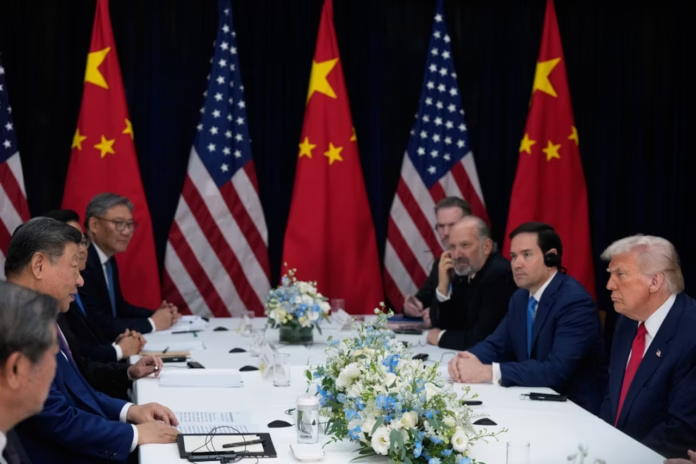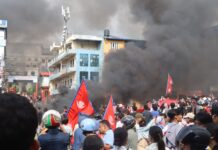Looking behind the uneasy truce in the US-China trade war
Vincent Kolo, chinaworker.info
100 minutes was all that was needed for the two ‘strongmen’ heads of the world’s main superpowers to agree a one-year truce in their long-running trade war. The surprisingly brief and therefore light-on-substance meeting in South Korea between Presidents Trump and Xi nevertheless revealed a great deal about US-China relations and the deep crisis of global capitalism.
This meeting was an on-again off-again affair, much like the wider trade and geopolitical conflict between the two sides. It took place at the Gimhae Air Base in Busan, a joint US-South Korea military base, an important detail as explained below. This was the first meeting between Trump and Xi Jinping for six years. The US president has talked obsessively about meeting Xi throughout the year, one of a number of dictators the US president admires and covets as his ‘friends’.
When the trade conflict re-escalated abruptly in early October, Trump briefly threatened to nix the meeting altogether, posting that there was “no reason” to go ahead, and threatening to raise US tariffs against China to 100 percent. This was in response to the CCP regime’s unexpected announcement of new more stringent controls on the export of rare earth minerals, a market that China completely dominates. Throughout this saga, the Chinese government gave no confirmation that Xi would meet with Trump in South Korea. China’s foreign ministry confirmed the meeting for the first time on the afternoon of Wednesday 29 October, the day before the meeting itself. This is another detail that may hold a deeper significance.
What was agreed in Busan?
What emerged from the meeting is far short of the comprehensive “12 out of ten” trade deal claimed by Trump. Its vagueness fits the same pattern as dozens of other post-Liberation Day trade agreements listed by the White House. Trump’s team extracted concessions from the Chinese regime and made some small concessions of its own. This is a shaky one-year truce at best. Further flare ups, new tensions and even a total breakdown of the agreement are implicit in the situation.
The Trump-Xi meeting was just for show, including the opening scene when Trump praised Xi as “a tough negotiator”. Their brief encounter only rubber-stamped what was thrashed out at a meeting of US and Chinese officials a few days previously in Malaysia. Trade experts point out that real trade agreements normally take around two years to finalise. Here we look at what each side agreed or gave away in Busan.
Rare earths: China agreed to a one-year pause on its new export controls for rare earths, not only for the US but for all countries. The US agreed to drop its counter threat of 100 percent tariffs. Trump announced that the “rare earth roadblock” has been cleared and lost no time boasting about the huge favour he has rendered other capitalist governments that have otherwise been squeezed by his policies.
The US also agreed to pause its threatened expansion of the Entity List to include subsidiaries, which if implemented would be a severe blow to Chinese capitalism. This policy is cited by Beijing as the trigger for its tighter rare earth controls. The Entity List is a US government blacklist of mostly Chinese companies branded a threat to ‘national security’, the most famous example being telecom giant Huawei.
China’s global lead in rare earths, accounting for 60 percent of mining and 90 percent of processing, shows how ‘democratic’ capitalism uses capitalist dictatorships when it suits them best. Rare earth minerals – indispensable for everything from phones, A.I. chips and F-35 fighter jets – are actually quite common, but their mining and processing can be hazardous for workers and the environment. Refining one ton of rare earths can produce 2,000 tons of toxic waste. Non-union semi-slave labour was the solution for global capitalism; so for decades this work was agreeably outsourced to China. Many of its rare earth producing regions have been devastated and may take 300 years to clean up.
Agriculture: China agreed to buy 12 million metric tons of US soybeans by January and then 25 million tons yearly for the next three years, plus other farm products. Trump boasted this was a “great deal” for US farmers but in reality this just sets the clock back to before Trump’s return to power. In a typical year, China has bought 50 to 70 percent of US soybean exports. Beijing stopped buying US soybeans altogether this year, switching to Brazil and Argentina, as a bargaining tactic in the trade conflict.
Port fees: Both sides also agreed to suspend docking fees on each other’s ships, which went into effect last month. This was something of a win for China because far more of its ships enter US ports than the other way around. But this is not a huge concession by Trump either. The shipping fees policy has so far made no impact in reviving US shipbuilding or slowing China’s dominance of the sector. The fees created a bureaucratic nightmare for US port authorities.
Chips: The US government refused to make any concessions (at least none that have been reported) on semiconductor exports to China. Trump said his government was only an “arbitrator or referee” between Beijing and the US tech companies. This underlines that the tech and A.I. war is the most decisive frontline within the wider trade war, which is overwhelmingly about military competition. Beginning with Biden’s government, the US has banned the sale of the most advanced chips to China such as Nvidia’s Blackwell chips, while the company itself is lobbying to relax the ban and make even more billions from the Chinese market. Nvidia is the first company in the world to reach a market value of 5 trillion US dollars, but the US and global A.I. bubble could be close to a crash.
Tiktok: No new details emerged on what Trump claims is a “done deal” allowing a US corporate takeover of the Chinese-owned social media platform. Beijing’s statement from the Busan talks said only that it will “work with the US to properly resolve issues related to TikTok”.
Tariffs: The most significant change coming from the Xi-Trump talks is the reduction in US tariffs by 10 percent, ostensibly to reward progress in stemming the flow of precursor chemicals from China used to produce the drug fentanyl. Trump made exactly the same claims about ‘progress’ on his first presidential visit to China in 2017.
Trump’s second administration uses the “drug war” as a key ingredient in its coercive foreign policy not just for the US-China conflict but even more blatantly in its military flexing in the Caribbean, where 64 people have been killed so far by US air strikes. The ten percent reduction leaves the average US tariff rate against China at 47 percent, still one of the highest levels in the world. China’s tariffs against the US are ten percent with a further 24 percent suspended under the truce.
Which side won?
Ninety nine percent of the global media seem to have got it completely wrong by claiming that China is winning the trade war and even that Xi Jinping and the CCP regime have emerged from the Busan talks “looking stronger” (The New York Times). Many left organisations such as the IMT/RCI make the same mistake of overestimating the Xi regime’s strength and underestimating the crisis in China. This is not about Trump or US imperialism being strong or stable. As we explained in previous articles, neither side will win this conflict. These regimes are expressions of the historic economic and political crises of US and Chinese capitalism.
The Chinese regime has bent the knee, acceding to a vastly unequal tariff arrangement – 47 versus 10 percent – taking this as the best it can achieve right now. This unequal rate is now locked in until November 2026 under the terms of the truce. Clearly this is no kind of victory. It is not better, and in some cases far worse, than many other regimes that capitulated to Trump from the outset.
That the CCP regime’s new rare earth restrictions, threatened on 9 October, which briefly stunned Trump’s administration, were just as abruptly withdrawn three weeks later, also raises myriad questions. If this was to increase China’s leverage before the Busan talks, as many Western commentators surmise, what concrete concessions did this achieve? What happened between these two dates – 9 and 30 October – that explains Xi’s dramatic u-turn? The answer to that question is the CCP’s Fourth Plenum.
Fourth Plenum: Xi’s wings have been clipped
The Fourth Plenum was a crucial and highly secretive gathering of the dictatorship’s top officials held on 20-23 October in Beijing. Superficially it changed almost nothing, with Xi Jinping emerging in “full control”. But in reality, the plenum seems to have been the arena of a brutal intra-CCP power struggle which may have significantly reduced Xi’s power within the dictatorial apparatus.
Most notably, Xi seems to have lost control – partially or wholly, it is very hard to tell – over the People’s Liberation Army (PLA), which is in the throes of its biggest purge in 60 years. Hundreds of generals and top officers have been removed. Most commentators simply chalk these purges down to Xi himself, a continuation of his earlier purges through which he concentrated power in his own hands. But after the Fourth Plenum it has become clearer that it is Xi’s military supporters who are being cleared out, arrested and disappeared, and it is the anti-Xi factions doing the purging.
There was an evident “Fourth Plenum effect” on Xi’s demeanour at the meeting with Trump. Some features of this encounter were very odd, even unprecedented, from the standpoint of the CCP and especially Xi’s own track record. Xi read verbatim from two A4 pages with extra large font, a fact that has been hotly discussed on social media. Trump spoke without notes.
The US and China should be “partners and friends”, Xi said. More remarkably, he told the US president, “You care a lot about world peace…. I appreciate your great contribution to the recent conclusion of the Gaza ceasefire agreement.” Anyone listening will be forgiven for falling off their chair.
Xi also acknowledged Trump’s purported role in brokering peace between Thailand and Cambodia. Sure, the Chinese regime has worked out that Trump is obsessed with winning the Nobel Peace Prize, and engages in some psychological manipulation for diplomatic purposes. But Cambodia, whose leader has just nominated Trump for the Nobel Prize (along with several other governments), is a client state and even an economic colony of China. Hamas has also been courted by the CCP. To acknowledge US primacy in these regional theatres, in the Middle East also including Iran, and in Southeast Asia, where the Chinese state has crucial geopolitical interests, even embellishing this as “peace”, is astonishing from a CCP leader.
Minor and major humiliations
For any Chinese leader to pay such tributes to one of the most aggressive representatives of US imperialism would be noteworthy, but for Xi Jinping, who has made wolf warrior nationalism his hallmark, this is absolutely extraordinary. And then Xi said that China’s development can go “hand in hand with Making America Great Again”. In case we thought this was a misprint, the report was carried in the official CCP media.
In addition to these decidedly un-Xi remarks other oddities were on display. Taiwan was not mentioned at all during the Busan talks, something that Trump later said (interview on CBS 60 Minutes) he found “surprising”. It is highly unusual for any Chinese leader, especially Xi, to not throw out at least a ritualised reference to Taiwan being an “internal matter” needing to be “handled correctly” by the US. In Xi’s last two encounters with President Biden, Taiwan featured as a key sticking point. At such a crucial juncture in the ongoing trade war, why didn’t Xi’s team at least air the Taiwan issue to get some extra leverage?
Additionally, in keeping with his aggressive militarist agenda, Trump announced just hours before the meeting that the US would start testing nuclear weapons again for the first time in 33 years – a move clearly aimed against the Chinese regime primarily, as well as Russia and North Korea, both bloc allies of the CCP. But Xi’s team in Busan chose to ignore the issue. Trump obviously timed his announcement to increase pressure on Xi before the talks. The lack of any reply indicates that Xi and Co were more desperate to get this deal done.
The meeting venue was also unprecedented, as mentioned. This is the first time that any leader of the PRC has met other government heads at a foreign military base, let alone a US (‘colocated’) base. This alone is humiliating for Xi Jinping. Trump’s government and its spy agencies are by now aware that the mother of all power struggles is underway inside the CCP, even if most of the media are blind to this development and judge Xi to be “firmly” in control. Restarting nuclear testing and insisting on the Gimhae Air Base in a city with plenty of luxury hotels and other neutral venues, were hardly random acts, but seem to have been calculated by Trump as a way to increase pressure and gauge the degree of Xi’s predicament.
While it is impossible to know exactly what is happening within the Chinese dictatorship, one of the most secretive of all ‘black boxes’, the regime’s sharp about-turn on rare earths and the radically different, bordering on submissive, tone of its notoriously nationalist president, suggest the CCP’s internal crisis is now extremely acute. This does not come as a surprise to ISA and Marxists, who have long reported on the devastating economic crisis of Chinese capitalism.
For US capitalism any immediate gains from Trump’s one-sided trade wars and imperialist bullying will inevitably be paid for – probably sooner rather than later – in the shape of a monumental crisis for the increasingly parasitic US economy, new foreign policy disasters and social explosions. Neither Beijing or Washington have answers to their own crises or the crisis of their global system.




